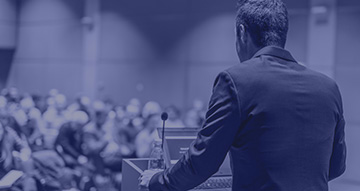COVID-19 has turned the world upside down and how! Globally, a majority of the workforce is working from home and that is the ‘new normal.’ According to a study[1] at the Stanford Institute for Economic Policy Research (SIEPR), in the United States alone, 42 percent workers are now working from home full time, accounting for more than two-thirds of economic activity.
Nearly four-in-ten people in the EU began working from home as a result of the COVID-19 pandemic, a new Eurofound Survey[2] has found.
Economies are rapidly changing. Markets are shifting by the hour. Majority of business houses are going through a massive downturn. At the same time, many business houses are making efforts to salvage the situation and are being diligent in rapid resource allocation. Consequently, business leaders and executives have been pushed into a dark arena they know little about. As leaders, however, they are expected to move ahead with the times and deal with the uncertainty to evaluate the situation, evolve with it and take decisions, putting aside their own fears.
It is during these critical circumstances that they are required to come up with novel strategies. Business leaders and management practitioners can take this pandemic as an opportunity to develop new managerial skills and establish effective management practices for their peers to emulate or not do anything and await the waves that will be coming to pass.
One of the greatest challenges facing leaders is that most of them may have a limited understanding of how to deal with such a dire global economic crisis and have naturally been caught unawares. Leaders who can reorient themselves and their activities manage to deal with the hard times and navigate their companies through the disruption. In contrast, leaders who do not reinvent some of their time-tested leadership skills tend to become anxious and stay away from taking action and barely survive the crunch.
So how should leaders prepare themselves to face a crisis, manage through it and come out of it successfully? To find out, we spent the last couple of months talking to top Human Resource (HR) leaders in 40 of the world’s best companies. Primarily in Chief Talent Officer (CTO) or Chief Learning Officer (CLO) roles, these individuals provided fascinating insights into what organisations themselves are identifying as critical capabilities in dealing with the COVID crisis.
Based on our work with leaders across organisations over the years, some key attributes and skills that future leaders need to develop in themselves to sustain through any crisis include accepting change as is, being empathetic and thoughtful leaders and being able to foster a growth-oriented mindset besides developing mature leadership skills.
The McKinsey Global Institute workforce surveyed[3] 3,031 business leaders in Canada, France, Germany, Italy, Spain, the United Kingdom and the United States to understand the skills that would be most in-demand by 2030. They found that the demand for higher cognitive, technological, social and emotional skills will grow, while the need for physical, manual and basic cognitive skills will decline.
From our recent studies of organisations during the pandemic, here are four key skills that leaders need to acquire to emerge out of a crisis successfully:
1. Seizing Momentum
One of the most common characteristics of leaders who struggle during crisis is an overreliance on processes. During such extraordinary circumstances, leaders need to step out of the processes-based rigmarole and seize the opportunity to lead their teams. Leaders who cannot work around weekly meetings, annual budgeting, decision making processes and so on will find it difficult to carry on. Leaders who thrive in an unpredictable environment focus less on process and more on outcomes. Exceptional leaders listen and sense the moments that have the biggest impact. People need direction and that is where the role of a leader becomes crucial in making the right decisions in times like these. The same is true of change. For several years we have been talking about and equipping leaders to ‘manage change’. It has become a staple of leadership development to learn the ‘change curve’ and think about the leaders’ role in helping people let go of the old and embrace the new. The old view of change encompassed a beginning, a middle and an end. The unstated assumption was that there was a ‘new normal’ after the change. However, leaders are increasingly experiencing a world in which change is constant. The most responsive leaders, therefore, expect this and rather than starting with a mindset of ‘how do we get through this change’, they start with an expectation that change is constant and with change comes opportunity.
This means we need to accept that many of the models that we have relied on to understand change, such as the Kubler-Ross Change Curve[4] are not going to be of much help anymore.
2. Empathy
Empathy is one of the most significant skills that a leader should possess and is even more crucial in times of crisis. The outbreak of COVID-19 has set in motion a period of slow growth. Layoffs, delayed projects and cost cuts have become a global pattern. With remote working, the workforce is juggling multiple roles- that of parents to young children, caregivers to elderly at home and of community members supporting each other in rough times. The level of exhaustion is naturally much more as workers are constantly getting on and off virtual meetings. The fatigue of home and work melding together is slowly taking a toll. A survey[5] by Blind, an anonymous professional network with users from companies like Amazon, Facebook, Google and Bloomberg collected data from 12,737 responders about fears of being laid off, and beliefs about how long it will take for things to return to normal. 57% feared being laid off while 40.6% believed it will take six months to one year for life to go back to normal. Pre COVID, a similar survey[6] by Blind conducted in 2019 had 35.9 % responders expressing fears of being laid off.
Another study by Blind captured emotional well-being due to social distancing in terms of loneliness, anxiety and productivity levels from 10,107 responses. 52.9% answered affirmative to increased loneliness during work from home while 56.4% reported experiencing increased feelings of anxiety during work from home.
Given this situation, only an empathetic leader will be able to handle team members with understanding and sensitivity. For working from home to be sustainable, leaders need to set the required boundaries such as communicating on a quick phone call instead of a videoconference, setting up office hours for specific groups, sharing tips on time management, and establishing that it is understandable if emails are not being answered after a certain hour.
Over the years, working with leaders at the helm, we have found that being an empathetic leader also gives one a chance to have a bigger sense of purpose. Let your workers voice their apprehensions. Keep in touch with colleagues and co-workers, check in on them often. Ask them if they are feeling overwhelmed at the end of the day or if they have too much to deal with. Commemorate little achievements of the team members to engender camaraderie and foster teamwork, despite being only virtually connected. Even 15-minute teleconferencing breaks or virtual watercooler chats allow for vital, healthy informal connections.
Not being able to foster connections in a non-traditional office set up is a struggle for many leaders. During one of the interviews, we found, “It may entail having to give up control and authority over the workforce”.
Technology plays a key role in our lives and so the human connection can still be encouraged over and above the usage of technology. It is not a hindrance in forging human bonds. Various social distancing norms in place have helped us realize that one does not always need to meet someone in person to communicate effectively. Active listening and open discussions that voice encouragement and reassurance can help build morale in the team.
3. Leadership maturity
To be a mature leader, one needs to build on an emotional development path from early on. Often, adults go through various maturity shifts - some in the way they see the world and can relate to others easily, while some still grapple with problems at hand not knowing which direction to head towards. Emotionally mature leaders embark upon a path of holistic development from early on. It is a path of simultaneous growth, where a leader continues to grow on their own, becomes a role model for others, and at the same time handles crises at work.
Leaders need to have that growth mindset, which is essentially about a willingness to make mistakes and learn from them. A true leader is one who not only notices when someone makes a mistake but is also there for them, asking all the right questions and discussing viable options to rectify the error in an attempt to develop better decision processes. Being empathetic towards others is a sign of emotional and leadership maturity. Leaders need not shy away from asking for help. It should be normalised for leaders in big institutional setups to seek help from their peers or teammates instead of being looked down upon as a feeble leader. Asking for advice does not make you weak or undermine your leadership.
Most leaders operate in a success-driven paradigm. They are constantly under pressure to lead from the front and stay on top of things. At times, a leader cannot do all this without facing exhaustion and saturation. So, stop trying to be a leader all the time. Be a follower and let others take the lead sometimes. Try not to micromanage everything and do not always assert your superiority. One can be a leader and yet be vulnerable. A leader is allowed to break the mould and seek answers. Create space for others to solve problems at hand.
4. Purposeful Strategy
The year 2020 is a curveball stronger than anyone could have imagined. Nevertheless, a leader needs to be a North Star - leading the way in spite of adversities and is able to move towards a larger social purpose even in turbulent times. Many of the business houses we studied as part of the interview series were proud of how they had responded to the recent crises, both in looking after their people and in supporting the communities they serve. For example, an African agri-business described how its belief that purpose needs to come before profit had helped them through the crisis. Their operations had to be kept running and they were reliant on local communities and the communities were reliant on them. So the business quickly pivoted from making alcohol out of sugar cane to making hand sanitiser. Not only was this a profitable innovation but it also was a way to contribute to the health of the community in challenging times.
Effective leadership is being able to see connections and interdependencies. Being able to see the larger picture enables leaders to take sharp decisions with minimal repercussions.
Post a crisis, leaders tend to look at it in two ways, either as a temporary disruption or a fundamental change to the way they thought and led. This frame of mind impacts the way leaders deal with the future. For example, leaders who struggled tended to think in terms of classic planning processes, taking current trends and projecting them forward to create a plan. But when the future has so many diverse and difficult possibilities, the accuracy of predictions is severely compromised. Consider this, the oil prices have fallen through the floor. As a CEO from a global energy company pointed out, “no-one in their wildest dreams could have predicted the drop off in demand for oil that we just experienced.”
Successful leaders took a different approach. Instead of looking at current trends, they envisioned future scenarios and looked back. They looked for ‘weak’ signals in the market and imagined the different ways in which they would evolve. These leaders then adopted specific courses of action with these in mind, constantly adjusting their picture as new data emerged. For instance, retailers that used to do 25% online sales are now relying on e-commerce to drive their sales which account for almost 70 % of their total business.
Mounting work pressure coupled with a complete change in the workplace scenario has brought back the missing purpose to leadership while also appealing to the humanitarian side of leaders.
Final thoughts
In a volatile and dynamic world where things may get disruptive, it is vital to be ready for change. Always look at change as an opportunity to learn rather than resisting it due to fear of failure. As you grapple with the uncertainty, do not get stuck in linear thinking which can be constrictive, instead explore multiple ways of approaching the same problem.
[1] Bloom, N.,2020. How working from home works out. Stanford Institue for Economic Policy Research. Policy Brief. Retrieved from https://siepr.stanford.edu/research/publications/how-working-home-works-out
[2] https://ec.europa.eu/jrc/en/news/coronavirus-pandemic-reveals-large-differences-prevalence-telework-across-eu
[3] Bughin, J., Subramaniam, A. & others, 2018.Skill Shift: Automation and the future of the Workforce. Discussion Paper. McKinsey Global Institute. Retrieved from https://www.mckinsey.com/featured-insights/future-of-work/skill-shift-automation-and-the-future-of-the-workforce
[4] The 'change curve,' derived from the work of Kubler-Ross, describes the internal emotional journey that individuals typically experience when dealing with change and transition. This journey consists of several stages that people go through: shock and denial, anger, bargaining, depression, and acceptance.
[5] Robinson, B. 2020. What Studies Reveal About Social Distancing And Remote Working During Coronavirus. Forbes. Retrieved from https://www.forbes.com/sites/bryanrobinson/2020/04/04/what-7-studies-show-about-social-distancing-and-remote-working-during-covid-19/#141fe0e6757e
[6] https://www.teamblind.com/blog/index.php/2019/02/11/worried-about-layoffs-tech-employees-weigh-in-about-layoff-anxiety/

Jerry Connor




